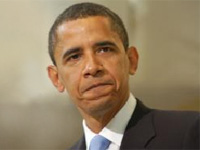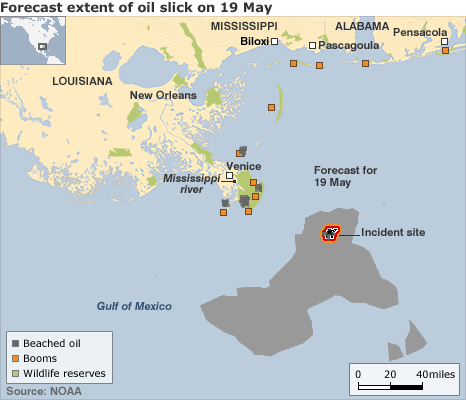US President Barack Obama to set up oil spill panel
 US President Barack Obama will set up a commission to investigate the oil spill in the Gulf of Mexico, officials say.
US President Barack Obama will set up a commission to investigate the oil spill in the Gulf of Mexico, officials say.They say the panel will also examine industry practices and the government’s role in the disaster.
The news comes as a top coast guard official warned the leaking oil may reach the southern Florida coastline.
Separately, the oil giant BP says it plans to start pumping large amounts of mud into the damaged oil well in an effort to close it altogether.
Oil has been spewing into the Gulf since BP’s Deepwater Horizon rig exploded on 20 April.
BP said on Monday it was managing to funnel the equivalent of 1,000 barrels a day of oil from the well to a tanker ship with the use of a mile-long tube.
That would amount to a fifth of the estimated daily spill of 5,000 barrels - an estimate made by the coast guard and BP.
Resignation
Mr Obama would establish a presidential commission by executive order, White House officials were quoted by news agencies as saying.
The officials, who spoke on condition of anonymity, said the commission would be similar to panels created to investigate the space shuttle Challenger disaster in 1986 and the nuclear accident at Three Mile Island in 1979.
It would also study oil industry practices, rig safety, regulation and governmental oversight, including the functions of the Minerals Management Service (MMS) - the agency responsible for regulating offshore oil drilling.
Meanwhile, senior MMS official Chris Oynes said on Monday that he would step down at the end of this month.
Mr Oynes has been accused of becoming too close to the industry his agency monitors, the BBC’s Madeleine Morris in Washington reports.
However, there has been no official comment on the reasons for Mr Oynes’ resignation.
‘Loop current’
Also on Monday, Rear Adm Peter Neffenger told the US Senate that the oil spill may reach Florida’s coastline.
Any oil that does wash up is likely to be in the form of tarballs which are a “little easier to manage”, the top coast guard official said in a testimony at the Senate Committee on Homeland Security and Governmental Affairs.
Rear Adm Neffenger also said that the government was closely watching whether the oil would be swept up into the “loop current” that moves around Florida.
“Currently it shows to be somewhere in the neighbourhood of 40-50 miles (65km-80km) from the southern edge of the spill,” he said.
“We are watching that carefully and as a result of that we are preparing for potential impact on the southern Florida coast and impacts around the southern Florida coast.”
Homeland Security Secretary Janet Napolitano also appeared at Monday’s hearing, the first time senators were able to question officials about the response to the 20 April disaster.
She said the government was monitoring the loop current very closely and were treating it as if it were a coastline.
“In other words… if we were to see that the oil really was beginning to move toward the loop current we would begin doing some things in the way of dispersant and booming… as if the loop current itself were a piece of the coast,” she said.
Senator Joseph Lieberman, who chairs the committee, said at the hearing that the government should not allow any new deep water wells to get permits or be drilled until the industry could prove it can prevent another failure of drilling equipment in deep waters or contain oil spills more effectively.
Plume questions
BP’s America president, Lamar McKay, returned to the Senate for the hearing, having already faced questions along with other oil industry executives last week.
Scientists said on Sunday they had found vast underwater plumes of oil, one 10 miles (16km) long and a mile wide, lending weight to the fears of those who believe the actual spill could be many times greater than the estimate of 5,000 barrels daily.
But Mr McKay told senators: “I think we ought to be cautious in terms of defining what plumes are out there and how they’re behaving.”
The US National Oceanic and Atmospheric Administration cast doubt on the plume reports, saying no definitive conclusions had been reached because the findings were unverified.
But, in a joint statement, Ms Napolitano and Secretary of the Interior Ken Salazar said the latest technique was “not a solution to the problem and it is not yet clear how successful it may be”.
BP also said on Monday it had received 15,000 claims for compensation, and had already paid out on 2,500 claims. Experts warn that BP’s total liability for the spill could run into billions of dollars.

You can return to the main Market News page, or press the Back button on your browser.

